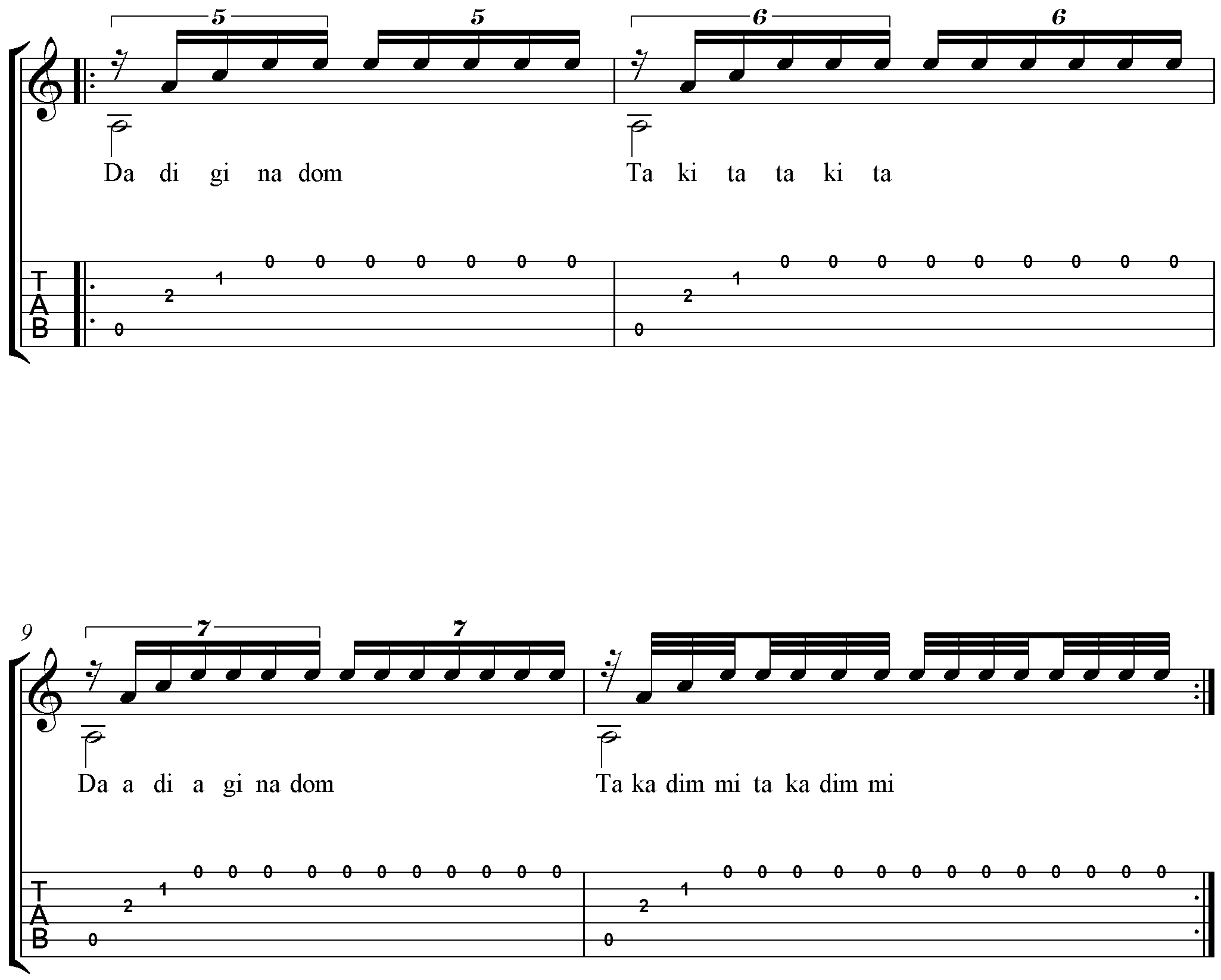
Approaching Etude No. 2 by Carcassi Part 1
This is the first part of a”super-lesson” for guitar, and it is going to cover approaching Etude No. 2 by Matteo Carcassi from Op. 60. If you are interested to see what a 19th century classical guitar etude has in common with Jazz, a freaky guitarist, metal and Indian classical Indian music!? Check out this lesson. We will be looking into arpeggio shapes and training the RH. There is a free download of the chord shapes and fingering available below.
This lesson is part of a series here at CGRocks, called Approaching, and it is for getting to grips with standard, and sometimes not so standard repertoire. Check out these two other lessons below from the series.
Carcassi’s Etude No. 2
Etude No. 2 by Carcassi is probably not the first study most people graduate towards from his Op. 60 set. But it should be, as the possibilities for training the RH arpeggio, tremolo and picado techniques are endless. It just depends on which one of these you wish to focus on. This is part one of a super-lesson, I did say endless possibilities, and will start with the most obvious and linear ideas, presented with micro studies, and then it will move into more advanced practice ideas. Let’s dive in.
Background
Op. 60 was published in 1851, two years before Carcassi passed away, and quite rightly sits at the heart of any educational attempt at learning classical guitar. It is full-to-the-brim with a lifetime of his knowledge and experience. It covers all the core techniques for guitar in a series of 25 etudes that range from just passed beginner stage to advanced intermediate. The pieces are typical 19th century harmony, and are therefore really enjoyable to execute and play.
Chord Shapes
In order for this study to get off the ground and be fluid, you need to get the chord shapes under the fingers solidly. We will only be concentrating on the first 4 bars here, but all micro studies can be taken through the entire piece, if you so desire.
Below is a bare bones analysis of the first 4 bars, so that you can see that all Carcassi is doing is walking through a, by this point well established, cadence formula: i to V7 back to i/(over the root note A in the bass); then finishing off with a standard ii V. Note the use of root notes in the bass – making the cadence stand out even more.
 Practice the shapes first on their own, before playing with the right hand pattern (See Below). Note that some shapes are duplicated across the fretboard – same fingering and shape.
Practice the shapes first on their own, before playing with the right hand pattern (See Below). Note that some shapes are duplicated across the fretboard – same fingering and shape.
Carcassi Excerpt & Guide Fingers
Below is the excerpt from Carcassi’s Etude No. 2, with a fair few of the standard right hand patterns for it.

Please note the LH fingering suggestions, these are based on a guide finger approach. The idea is to connect the chord shapes up with common fingering solutions. And yes that does mean using the weaker fingers of the LH – think of it as an excellent strengthening workout for these digits. Hint: the guide fingers are the numbers that are duplicated one chord change to the next – bar 1’s guide finger is: 3.
Aims
Taken on their own, those two examples above are actually quite a lot to practice, and together they will work the RH arpeggio/tremolo, LH equal strength and shifting. At least to begin with, if this is new to you, that is what you should be aiming for.
Linear Thinking
Right with the basics out the way, let’s move into intermediate territory with some truly linear out-of-the-box ideas. First up are what I call the mighty 5.
5 Patterns for Tricky Parts
The mighty 5 patterns below are considered standard practice for getting fingers, and head, around tricky or demanding passages. They force you to re-evaluate the knowledge you think you have about the passage. And thus solidify it securely into your neural system, physical muscle memory, aural memory and visual memory. They should be utilized on any music, that gives you hassle or that just isn’t flowing perfectly, or that you keep tripping up on. They work!

The fingering suggestions are not here as these patterns can be used with any. Try it now on one of the RH, or LH, fingering suggestions you haven’t practiced yet, go through all 5 – mindfully – and then take a break. Come back and just play. See what happens, don’t just take my word for it.
OK so that is the intermediate section of this Carcassi Etude No. 2 lesson. Curious about what the advanced could show you? Check below.
Tuplets & Konokol
Now we have covered pretty much most bases, and you should be able (if you have applied all the suggestions above to the entire study) play through Etude No. 2 confidently. Remembering that guide fingers are essential to getting this etude up and running – so choose your fingering well with the next chord shape in mind. Let’s move onto more advanced ideas – tuplets.
Tuplet
A tuplet is just a fancy word for irregular (or odd) note groupings. So any set of notes that are beamed together and have a 3, 5, 6 and 7 above them. (Or any other numbers that are generally odd.) For our Carcassi etude that will be groups of 5, 6, 7 and then high speed 8’s.
Why should I practice these? You ask!
Well I am a firm believer in practicing advanced ideas or thinking on, and in, simpler music. So by the time you reach this point of practicing this etude, you will be playing it very well and it should be effortless. So why not harness that easy etude to practice higher powers – tuplets, along with strengthening the RH mechanism. That way when you move on and upwards, repertoire wise, they won’t pose a problem for you, because you already have them in the bag.

Above is the first bar rewritten into a tuplet idea. Again no RH fingering suggestions, get them from the excerpt above. Below them are the konokol syllables that will help practicing these.
Aims
Say & play
It really is that simple. These syllables are great “transport exercises”, they can (and should) be practiced as you go about your daily commute. Tap out a simple crotchet beat and then say, mentally if needs be, the syllables. Aim for fitting then into the allotted space between beats evenly. Walking and saying these is even better, use your footsteps as crotchet beats and say and play the tuplet syllables.
Konokol
All konokol is, is a system of syllables utilized in South Indian classical music to teach drums and rhythms. It comes in very handy for learning those tricky 5’s or 7’s, and even 6’s and 8’s. So,
Say & Play
slowly at first and then with a metronome – to really solidify things. Check out this video of John McLaughlin and Ganesh Vinayakram explaining the basics.
https://www.youtube.com/watch?v=sUCYkXMHU-I
And if that wasn’t enough here is the ever awesome and freaky Matthias IA Eklundh doing another explanation.(I do think he should have been a drummer, his independence is impressive. Try tapping your foot and fitting in 5 beats with accents!!)
Konokol is every where, trust me!
Hopefully you enjoyed part 1 of this super-lesson on Etude No. 2 by Carcassi. Believe it or not there is actually a part 2 in the pipeline (and possibly even a part 3). If you liked this and what to stay ahead of the curve, consider signing up, and you will get the lessons delivered straight into your inbox.
Free Download Below
Free download of a cheat sheet with the fingerings and positions of the chord shapes, plus tab.
Carcassi Part 1 Cheat Sheet

